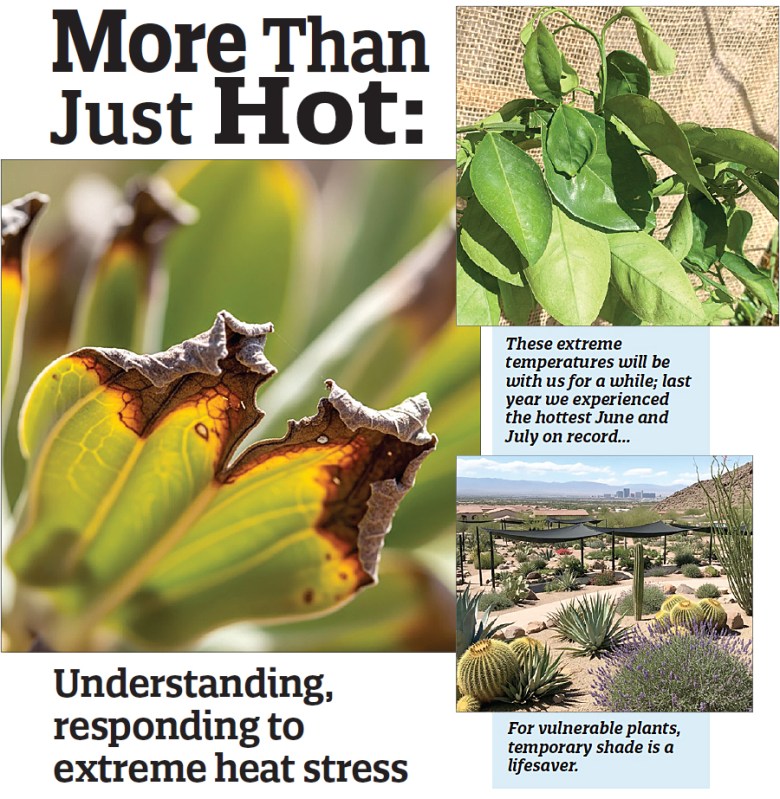
Here we are, deep into June; Las Vegas summer is in full, blazing force. Last month’s “Beat the Heat” guide covered essential preparation. Hopefully, you’ve put those steps into action—deep watering, mulching, and smart plant choices are crucial. But even with diligent prep, extreme heat pushes plants to their limits.
This month let’s explore common heat stress signs and what steps you can take.
One common sign is wilting, even in watered plants. Afternoon droop or “Flagging” is temporary, a plant’s natural defense. If wilting persists into the evening or morning, it’s a sign of severe dehydration. Another sign is sunscald, or plant sunburn—look for crispy, brown edges or dry spots in the middle of the leaf. It hits both new & mature leaves when intense sun, heat, and insufficient water combine. Young plants, non-natives, and fruit tree leaves are especially vulnerable.

Beyond general wilting and sunscald, you might observe significant leaf drop on Bottle Trees, Japanese Blueberry, and African Sumac. While alarming, don’t panic! This is a survival strategy: older, less acclimated leaves are shed to conserve water. Simultaneously, look for new, smaller, tougher growth. These new leaves are better acclimated to the intense heat, representing active adaptation to survive and thrive.
During extreme heat, plants shift to survival mode. New growth slows or stops. Flowers may drop, and developing fruits can abort or remain small. Stressed plants also become more susceptible to pest infestations like Aphids and Spider Mites. For edibles, watch for blossom end rot (often calcium deficiency from inconsistent watering) or fruit cracking from sudden water uptake.
Dr. Q’s Solutions & Next Steps
Your watering routine needs refinement. Continue deep, slow watering in the early morning. Avoid shallow, frequent watering; always check soil moisture a few inches down before applying “extra
water”. Ensure emitters and drip lines work correctly. For vulnerable plants, temporary shade is a lifesaver. Cover with Burlap or 30-50% shade cloth during peak heat (noon to 4 PM), securing it. This provides essential relief from direct sun exposure.
Maintain pest vigilance. For early Aphid or Spider Mite signs, a strong hose blast can dislodge them. Insecticidal soap can be used in the evening if needed.
These extreme temperatures will be with us for a while; last year we experienced the hottest June and July on record, so, patience is key. Some leaf discoloration or temporary wilting is inevitable. Your established desert-adapted plants are tough, and many non-native plants will rebound when temperatures recede.
Navigating summer’s peak heat demands smart strategies. By understanding heat stress and taking these steps, you can help your desert oasis endure. Remember, your local Star Nursery experts are always here for personalized advice and will guide you to the right Dr. Q’s products and beyond.
Question: Curious Carla from Henderson asks, “Dr. Q, my plants look so tired in this heat. Should I prune them back or give them a boost with fertilizer to help them perk up?”
Answer: That’s a common question, Carla. During extreme heat, it’s crucial to avoid stress-inducing activities. Put away pruners; new growth is sunscald susceptible. Resist fertilizing; plants can’t sustain growth under stress. Forcing growth now can exhaust them, leading to decline or even death. Let plants rest. Wait until temperatures drop in late September or October for major pruning or fertilizing.
“Star Nursery Your Garden’s Partner for Every Bloomin’ Thing.”
I’m Joey Lynn, and I’ll see you next month.


